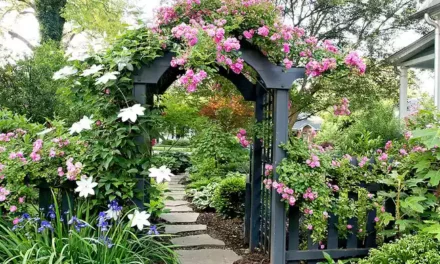Flowers make any landscape more beautiful. But there are a few things to know about how to design a flowerbed for maximum impact. By keeping these concepts in mind, even beginners can create a bloom-filled yard that will look pro-level.
Just keep an eye on this article and get amazing ideas for your garden decoration with Pritish Kumar Halder.
:max_bytes(150000):strip_icc():gifv():format(webp)/brewer-garden-flowering-shrubs-2580f44c-7863d4c175a7472fae713498f28be381.jpg)
Research Flower Characteristics
The best flower garden designs incorporate several types of flowering plants, including long-living perennials, short-term (but long-blooming) annuals, seasonal bulbs, ornamental grasses, and vines. Before you officially get started on your flower garden design, do a little research on what types of plants will grow best in your area, what colors and textures they offer, and any special care they might need.
:max_bytes(150000):strip_icc():format(webp)/golden-smokebush-bd4713f5-13a95df28f6c498da783d2d3c97c8807.jpg)
Choose Your Flower Garden Design Style
Your personal preferences (or your home’s architectural style) can help set parameters for your garden’s style and size. Different flower garden design ideas and styles lend themselves to different types of plants. For example, a contemporary-leaning landscape might take a minimalist approach and feature clearly define flower beds with hard lines; a cottage-style garden like the one pictured here, encourages a mix-and-match approach with meandering paths and bed shapes. If you enjoy bringing flowers indoors, consider creating a perennial cutting garden.
:max_bytes(150000):strip_icc():format(webp)/cottage-garden-path-landscape-01711dab-584a67641f4a4df7836946a8ea9a68a5.jpg)
Determine the Garden’s Shape and Size
Flowering plants can be arranged in beds of almost any shape and size, from expansive rectangles to petite corner beds. To get an idea of how your flower garden will fit into the rest of your landscape, use a garden hose to outline the edges before you start digging. Walk around the bed; look at the proposed garden bed from every viewpoint. Test if you’ll be able to access plants in the middle or if you’ll need to include a path. If you’re specifically looking for flower garden ideas for beginners, start small: You can always expand your plan if you want, or go bigger next year.
:max_bytes(150000):strip_icc():format(webp)/tough-as-nails-perennial-garden-705dfeb9-327c463bacf64657aef5e42305c0a2aa.jpg)
Select Flowering Plants
Once you’ve decided on your flower garden’s design, shape, and size, it’s time to put your plant research into action. Consider show-stopper plants you want to use as a focal point, flower sizes, year-round interest, bloom time, and color combinations. Also think about bonus attributes such as fragrance and whether the flowers will attract butterflies, hummingbirds, and other pollinators.
:max_bytes(150000):strip_icc():format(webp)/allium-flowers-garden-d2c7cfb7-ed7a80f15f7346c080861bfabc62945e.jpg)
Evaluate Plant Size
Consider a plant’s full height when making your selections. For example, if you want to plant a colorful foundation garden along the front of your house, the tallest plants will need to go in the back, but shouldn’t be so tall that they block windows or doors. If your flower garden design is an island, the tallest plants should go in the center. Also keep a plant’s mature overall size in mind to make sure it will have enough room to grow without crowding its neighbors or spilling out of the bed too much.
:max_bytes(150000):strip_icc():format(webp)/garden-plan-foundation-8a3868c0-a619a25252f943b3aac18f3dd8f3cb61.jpg)
Review Bloom Times
Well-designed flower gardens include a variety of plants with year-round interest and staggered bloom times. Evaluate both factors before selecting plants. You don’t want to create a garden that’s full of color in the summertime but bare in autumn. That’s another reason it’s important to combine different types of plants: It’s easier to make sure all the seasons are covered. For example, you can rely on shrubs to provide spring blooms and winter structure, summertime perennials, and fall-blooming annuals in your flower garden design.
:max_bytes(150000):strip_icc():format(webp)/curved-path-through-full-shade-garden-0c339a6b-d992867929f842b6b5d52006f54355d7.jpg)
Select Complementary Flowers and Foliage
Creating the best color combinations in your flower garden design can be tricky. A good place to start is the color wheel. For example, gardens planted in shades of the same hue, like pink, are pleasing to the eye. Colors next to each other on the color wheel, like purple and red, look good together, as do colors across from each other, like purple and yellow. Foliage can also provide much-needed texture and color for visual interest when blooms have wilted away.
:max_bytes(150000):strip_icc():format(webp)/pink-purple-flowers-field-85de6b7d-a61f83f2b9b8448a9a49f614397b9c01.jpg)
Rely on Repetition
When laying out your flower garden design, aim to have more than one of each type of plant repeated throughout the bed. It’s a visual design trick that creates cohesiveness so flowerbeds feel less jumbled than a hodge-podge collection of plants. And including at least three (or any odd number) of the same kind of plant in a grouping is most pleasing to the eye and feels more dynamic (as opposed to a more symmetrical look from even numbers).
:max_bytes(150000):strip_icc():format(webp)/flower-garden-walking-path-f6d813c2-610fa51d1b794241927d4db7015b0452.jpg)
Supply a Focal Point
Every garden bed, no matter how big or small, needs a focal point that gives the eye a place to start before moving on to the rest of the flowerbed. That could mean anchoring a large bed with boxwood shrubs in the corners and a flowering shrub in the middle or planting a mass of a single flower type in the center of a skinny border. You can also add an interesting piece of garden art.
:max_bytes(150000):strip_icc():format(webp)/sustainable-garden-design-102627721-58d4db0c6783417d8e5019c13ce8f471.jpg)
Incorporate Hardscape
Hardscape elements, like pergolas, trellises, and arbors are beautiful complements to flower garden design. If you’re crafting a bed that flows from front yard to backyard, for example, a simple arbor draped with a climbing rose can help mark the transition from public to private spaces. They also work as focal points.
:max_bytes(150000):strip_icc():format(webp)/simple-white-painted-curved-arbor-7768e257-cce585c5672147c68d1376742d5b99e8.jpg)
Prepare the Planting Bed
Once you’ve decided on all the elements you want in your flower garden design, it’s time to prep the bed by clearing away grass, weeds, or other debris where you want to plant. If it’s a new, empty bed, add in plenty of compost to boost the soil quality for your flowers. If you want to have a path running through your flower garden, lay that out before planting to make sure there’s enough space for everything. You may also want to add edging, such as pavers or another material at this point, or you can wait until after you’ve finished planting.
:max_bytes(150000):strip_icc():format(webp)/leaf-stepping-stones-garden-5d33f4b9-d625216cdec2416798ee0cb24de83410.jpg)
Plant, Water, Mulch, and Enjoy the Show
Now, it’s time to buy your plants! Do your best to stick to your list; it’s easy to get carried away when you’re face-to-face with all the beautiful options. While still in their nursery pots, place your plants on top of the soil where you want them to go before you dig any holes. That way it’s easy to see if you have enough plants to fill the space adequately or make adjustments the arrangement. Once you’re satisfied, start digging and popping the plants into their new homes. Any newly planted flowers should be well watered. Then add an inch or two of mulch over the whole bed. Monitor your rainfall and water as needed, ensuring that your plants receive about an inch of water a week.
:max_bytes(150000):strip_icc():format(webp)/planting-pink-flowers-0730b2f0-95d5c9c2f02a4db5bf6c3c4faca67390.jpg)
Reference
https://www.bhg.com/gardening/design/styles/successful-flower-garden-design/











